 |
submitted by /u/henrythemeanBOT [link] [comments] |
Year: 2021
-
That escalated quickly….
-
What are Voice Bots? Difference between Chatbots and Voice Bots
Voice technology is highly into the trend and giving people a new way to interact and execute their day to day tasks. Not only are people deploying it for personal use, but businesses also use its potential and grabbing opportunities with chatbots. They are different but have one motive- better customer experience. Here is more.
submitted by /u/botpenguin1
[link] [comments] -
ManyChat & Shopify Advanced Training Needed!
I am looking for an advanced Manychat/Shopify training course if anyone knows of one please suggest one below!
submitted by /u/KingBeven
[link] [comments] -
best bot just to talk to
I don’t want to spend money, I don’t have any requirements. I just want a link to the best free online chatbot you know.
submitted by /u/DeeperInTheVoid
[link] [comments] -
Why Chatbots could be the next big thing for SMEs
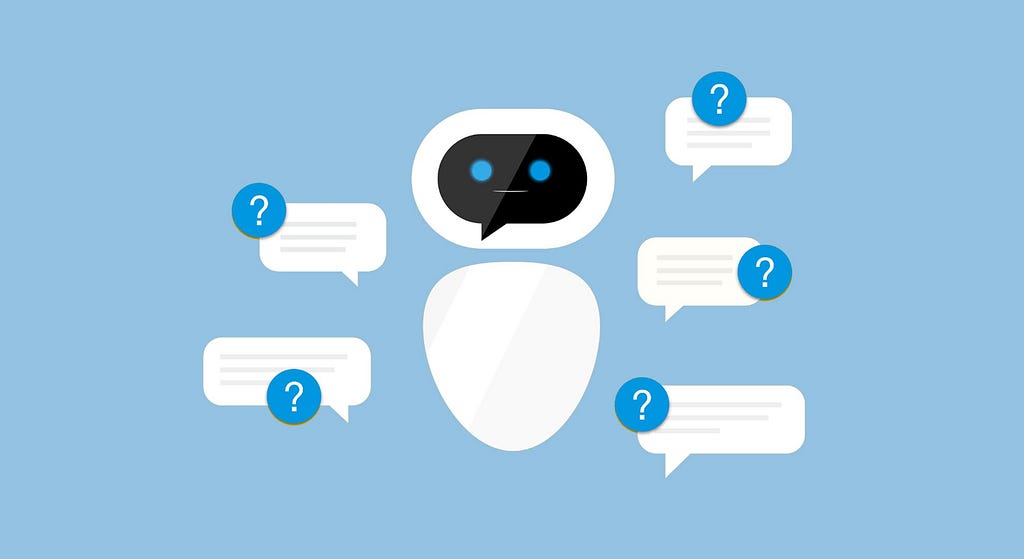
It’s hard for SMEs to compete with big tech companies with limited resources nowadays. Whenever you build an app, you need to craft the web version, an Android app, and an iOS equivalent. You probably need a UX designer and a few developers with different skillsets to work on the different platforms. It’s slow and expensive.
And worst of all, your app is doomed from the beginning. People now already have hundreds of apps installed on their mobile phones. And human brains can only remember the last 7 apps they used. Your app will probably be hidden in some folders and be forgotten forever if not uninstalled.
That’s why we created a chatbot to replace the traditional app. And it solves a few problems all at once.

One app rules them all
A chatbot is basically an app that you can interact with the commonly used chat interface. It does not exist in itself, instead, you can use it on your website or in a chat app like Whatsapp, Facebook Messanger, Teams, Slack, Line, etc. So you don’t need to build different apps for different devices.
Once you build your bot for Whatsapp, users can use it wherever they can use Whatsapp. You don’t need to worry about OS or browser compatibility. And the best part, users don’t need to install anything. Just add your phone number to their WhatsApp, they can start using your bot. (For other applications like MS Teams, they may need to search for your bot in the Teams market place and “install” it.)
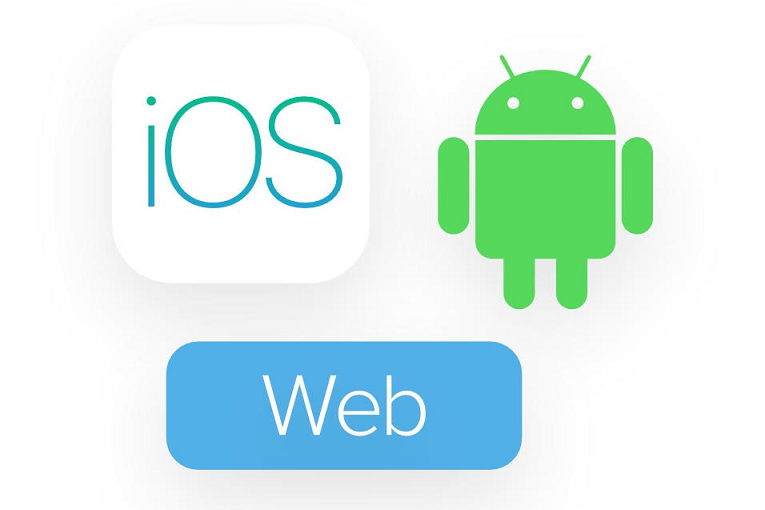
And just like fashion, UI design changes all the time, but what doesn’t change is the way people chat. When you type something, you expect some message response, it’s simple as that, and it won’t change dramatically in the coming years.
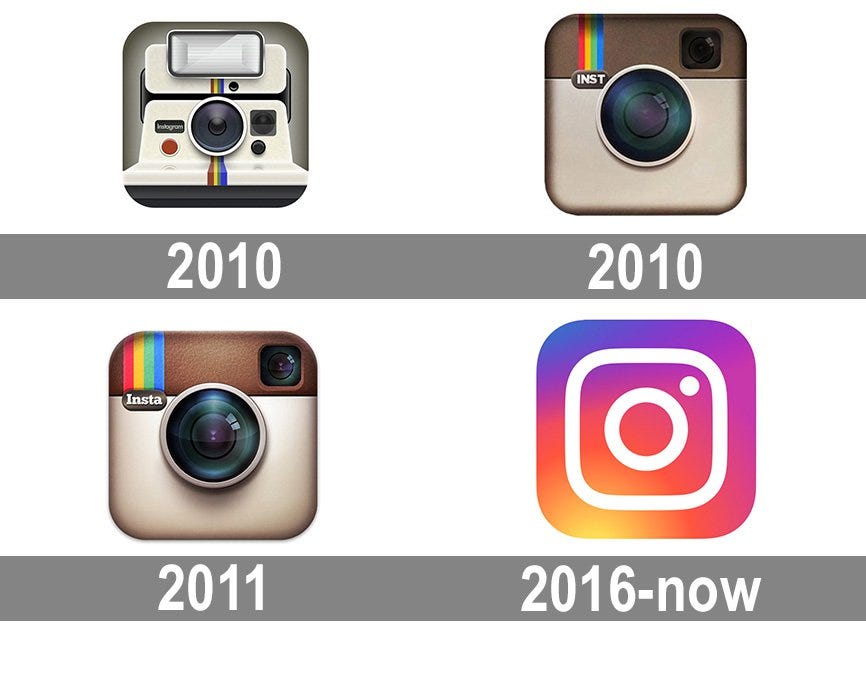
Trending Bot Articles:
4. How intelligent and automated conversational systems are driving B2C revenue and growth.
Better user experience
Form-based user inputs haven’t changed for many years. For people old enough like me, we use to fill in a lot of forms on paper. Nowadays all things are online, but it’s still form-based. Nothing much has changed about that. Even when employees tried to apply for leave, you present them a form, ask them which “Leave Type” they want to apply, and whats are the “Start Time” and “End Time”
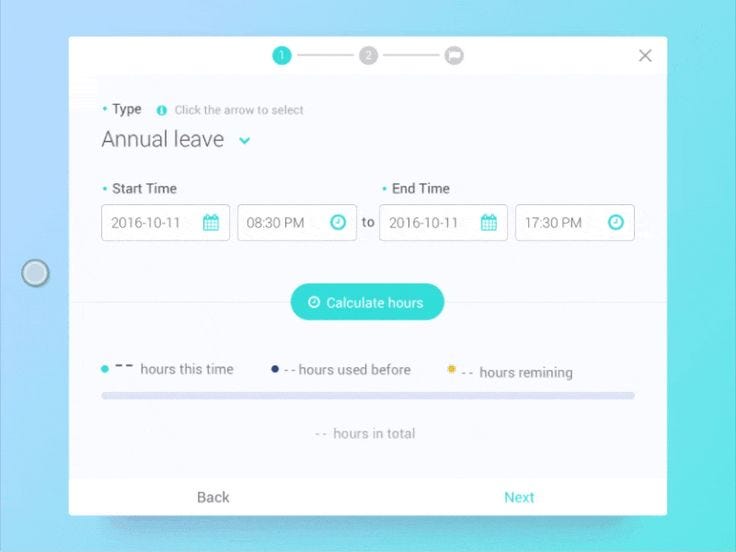
What users really want to do is simply “apply ABC leave on XYZ date”. A form is unnecessarily complicated. A simple text message can get the job done in a simple and natural way.
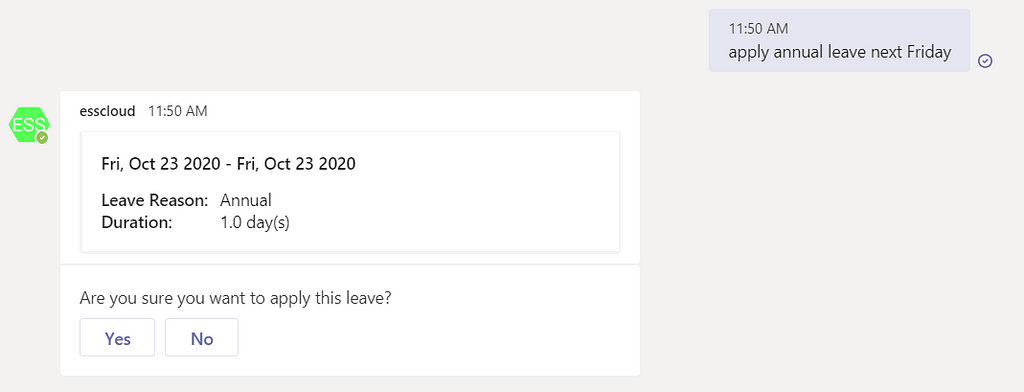
Another problem with the traditional UI design is navigation. You have a lot of features in your app, but you can’t put all of them on your home screen. So we need to create secondary menus to hide them. No matter how well you design your secondary menus, some features will be buried deeply and very difficult to find.
With a chatbot, you don’t need to remember where the buttons are or which menu it’s hidden. Every feature is just one message away. (Of course, your users need to know the feature exists in the first place).
Connect with your users
Emails are dead. My personal email is full of marketing materials and useless information that cleaning up mailbox is becoming a daily chore. Yes, I already set up countless filters to block 99% of them.
And good luck with your in-app push notifications, most of the time people will just clear the unimportant notification as soon as they can and if you are too aggressive, they will uninstall the app altogether.
Residing inside their favorite chat app has the advantage to be really seen by the users. It’s like in the old days, when you really like a girl, you will go and ask “Can I have your phone number”, so when you send her a message, she will probably really read it. Nobody will ask about an email address, but yet that’s what most companies are doing.
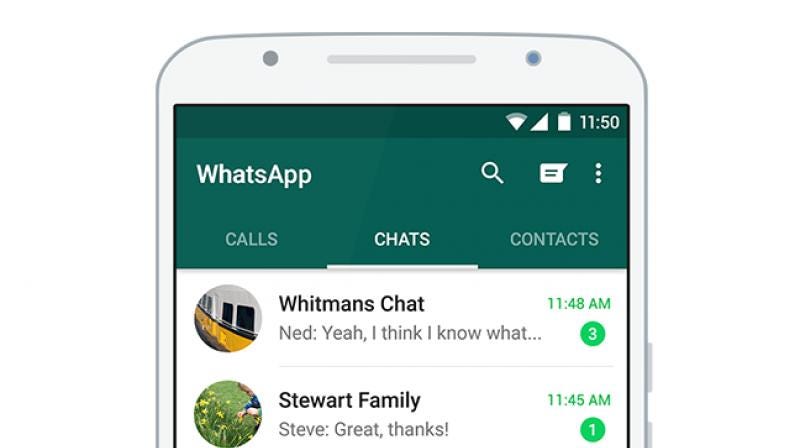
This messaging nature also makes a lot of company workflows easier. When there’s something pending your approval, you don’t need to open a separate web page, just send your response in the chatbot. And the counterpart will receive a message in real-time as well.
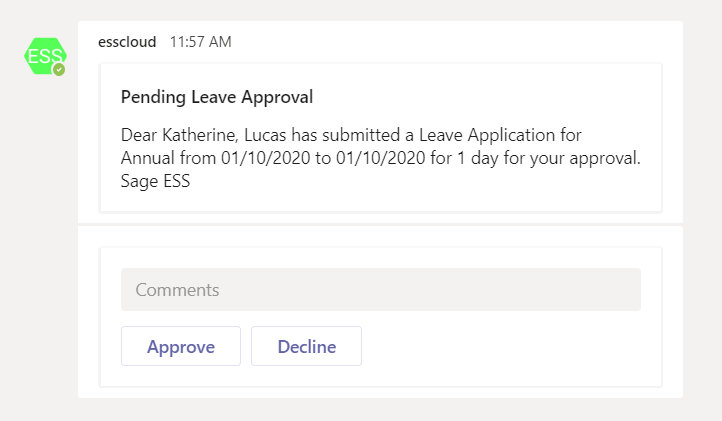
I’ve built a chatbot to replace/supplement our Employee Self Service web app which our users use to manage our leave and payslips records online. The use case is fairly simple and it fits into the bots perfectly. It can handle common scenarios like
- Apply ABC Leave on XYZ date
- What’s my leave balance now?
- Show my leave history
- Who is on leave on XYZ date/Is ABC on leave on XYZ date?
- Send my payslip in XYZ month
- Approve/Decline employee’s leave
I started this bot as a part-time pet project, and it grows into a fully-featured bot in around 2 months time. The development time is significantly shorter than building mobile apps, yet all the main features are achieved. In fact, some features are actually better than traditional apps, for example, workflow actions are easily integrated into the message, and you can send a voice message if you are too lazy to type.
Of course, there’s no one-size-fits-all solution, but it could be a good alternative in future app development.
Don’t forget to give us your 👏 !



Why Chatbots could be the next big thing for SMEs was originally published in Chatbots Life on Medium, where people are continuing the conversation by highlighting and responding to this story.
-
How to build Alexa Skills without coding knowledge
How to build Alexa Skills without
coding knowledge (2021)
Building Alexa Skills without coding When talking about Alexa Skills building, the common things that come to someone’s mind is AI, programming language, complicated coding, and so on.
You may also think that projecting and executing the creation process is very complicated too.
For most of the process, all of the difficulties mentioned above remain true. We state “for most of the process” since nowadays, it has become easy to build your own Alexa Skill, where all is needed is the idea of what you want it to be for.
Now, it is much easier to create them since the No Code trend has influenced how Amazon manages the Skill creation process.
How Amazon Alexa and Skill building started
It started in November 2014, when Amazon launched its series of Amazon Echo devices, which were Alexa-enabled smart speakers.
They weren’t Alexa themselves, but they were the best channel of receiving the voice request, sending it to Amazon Servers where the hard processing work is made, and obtaining the answer or action requested.
It started with nearly 100 abilities Alexa was capable of doing, even though it now has more than 120.000 Skills available.
This all was made possible in mid-2015 when Amazon released a dedicated platform that would allow every interested developer to create Alexa Skills: the Alexa Skills Kit.

How Amazon made it possible for everyone to build Alexa Skills
Since the developers weren’t the only ones with the desire to build Alexa Skills, use and publish them, Amazon came with a bright solution in 2018.
That solution was Alexa Skill Blueprints. A way for non-developers to build simple Alexa Skills and use them. They even prepared an entire series of tutorials on how to use them.
In their effort to gather more developers and work for creating more Alexa Skills, Amazon made it easier through the Amazon Web Services (AWS) console and Alexa Developer Portal.
This would take the Skill-building process to arise, especially with Amazon supporting the developers and those interested in improving the voice technology. It was the Alexa Fund: dedicated to those with the intention of working in new voice technologies.
There are also the Alexa Developer Rewards and Alexa developer promotions to encourage the developers committed to adding and improving the Skills available in the Alexa Skill Store. Great support would be AWS promotional credits, which would reduce the cost of AWS resources used by the developers while building Alexa Skills.Trending Bot Articles:
4. How intelligent and automated conversational systems are driving B2C revenue and growth.
How to build your Alexa Skill without coding or technical knowledge
With everyone, be it an individual or a business, looking to create an Alexa Skill, new opportunities are arising. Every developer or developing platform is trying to simplify every step of the Skill Building process.
The number of people aiming to create an Alexa Skill is increasing. Not only to become a professional Alexa Skill developer but also for personal use. Be it as a hobby or for their businesses.
While for individual users the process of Skill building is simple, for the business ones is more complicated.
This is where a third party Developing Platform comes in to help.
With a simple interface, you can implement all the parts needed to complete the Skill and make it ready for publishing.
Not only that but also modify the content of the Skill if needed and also, test it, publish it and check how your Skill performs when made available in the Alexa Skill Store.
All of this is available and free to access on Ipervox.
Why is Ipervox the right choice to build your Alexa Skill?
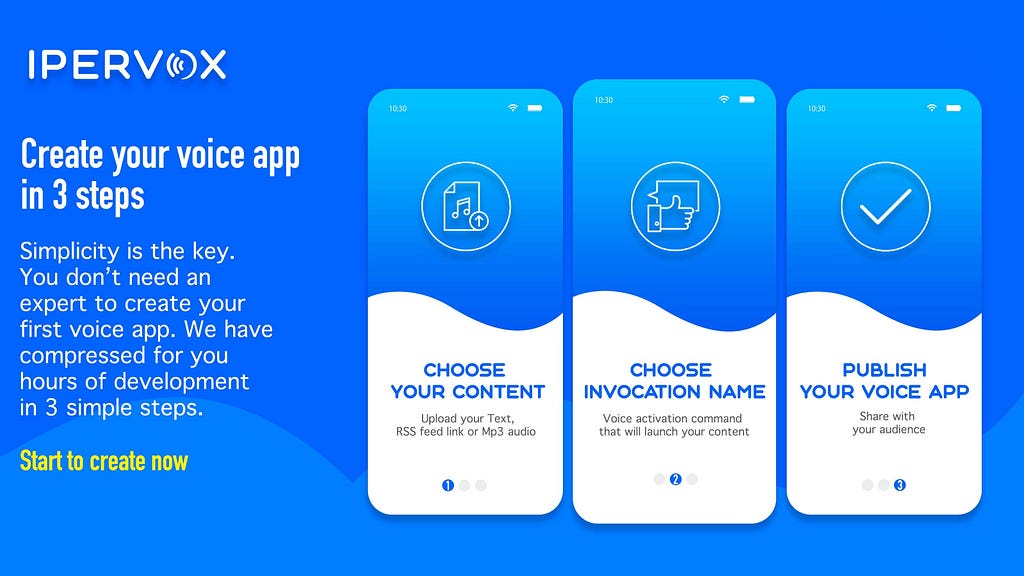
Picture showing three main steps on how to build an Alexa Skill with Ipervox In case you’re a complete beginner and need more information about what are Alexa Skills and how to create one, you can start by using the Ipervox platform.
Viewing the tutorials made available from our team or checking our FAQ site will make everything understandable.
This development platform has a simple and user-friendly interface, which allows every user to effortlessly build the Skill they want and how they want it to be.
With a well guided interface and a structure oriented in detailed Skill Building, Ipervox allows you to manage and easily control every step.
It helps reach the desired product at the end, giving shape to the initial idea that inspired you to create the Alexa Skill.
Above we mentioned Alexa as a tool for businesses. Ipervox has created several tools and guides to assist every business and entrepreneur in building their own Alexa Skill.
This will help you reach your audience and customers with the most straightforward tool there is: the Voice.
Voice technologies are emerging as the best and promising tool of the future. Not only to reach but also to engage with all of your clients.

Embracing it now means you will have a safe spot in the future. A future where Voice Apps become a common thing for businesses to use.
Create your Alexa Skill using the Ipervox online platform with the set of instruments made available from us. It will help you improve the interaction with your audience, gain their attention and their hearts.
If you want to create your Alexa Skill right now, all you need to do is click “Start for Free”, and you can start building a new channel. A channel that will connect you with your new audience.
Don’t forget to give us your 👏 !



How to build Alexa Skills without
coding knowledge was originally published in Chatbots Life on Medium, where people are continuing the conversation by highlighting and responding to this story. -
Getting started with the Relay SDK — node.js edition
Getting started with the Relay SDK

Hey folks! Let’s get started with a quick example showing how you can use the Relay node.js SDK to create a simple number game. For this example, we’ll use Heroku to host a Websocket that will maintain a connection with the Relay Server.
First, create a new app using Heroku. We’ll be naming ours ‘relay-wf’:


Next, let’s setup our environment with git and Heroku CLI (instructions for windows/linux):
$ brew tap heroku/brew && brew install heroku
$ heroku loginNext, let’s initialize our environment:
$ cd relay-wf
$ git init
$ npm init
$ npm install relay-jsNext, we’ll setup our example interaction & deploy it to heroku. Here we are creating a basic app that let’s users guess two numbers and returns the one who guest closest
Trending Bot Articles:
4. How intelligent and automated conversational systems are driving B2C revenue and growth.
# workflow.js
import relay from 'relay-js'
const app = relay()
app.workflow(`numbers`, workflow => {
relay.on(`start`, async () => {
const user = await relay.getDeviceName()
const random = Math.floor(Math.random() * 10) + 1
await relay.say(`Player One, pick a number between 1 and 10`)
const numberOne = await relay.listen(["$DIGIT_SEQUENCE"])
await relay.say(`Player Two, pick a number between 1 and 10`)
const numberTwo = await relay.listen(["$DIGIT_SEQUENCE"])
if (Math.abs(numberOne - random) < Math.abs(numberTwo - random)) {
await relay.say(`Player One wins! ${numberOne} was closest to ${random}!`)
} else {
await relay.say(`Player Two wins! ${numberTwo} was closest to ${random}!`)
}
await relay.terminate()
})
})Next, we’ll add our workflow configuration to Relay servers. First, fire up Dash by going to api-dash.relaygo.com (for production, this is dash.relaygo.com) and navigate to the Workflows section and select the Create button for ‘Custom Workflow’ :

From there, you can enter your workflow configuration. This includes the name of your workflow (here we’ve named ours ‘numbers’), the devices you’d like it on (we’ll push to just one device here, ‘Ibraheem’) and URI hosting the workflow (relay-wf.herokuapp.com). We’re also using the spoken phrase ‘pick a number’ to initiate our workflow from the device.

Save your workflow and then let’s deploy our workflow node.js app to heroku:
$ git commit -am 'Initial deploy'
$ export HEROKU_APP=relay-wf
$ git push master heroku
$ heroku logs --tailAnd that’s it! If everything worked, you should now be able to speak ‘pick a number’ into the Relay assistant and trigger your number game!
Ready to start developing with Relay? Click here to signup for our Relay SDK beta.
Don’t forget to give us your 👏 !



Getting started with the Relay SDK — node.js edition was originally published in Chatbots Life on Medium, where people are continuing the conversation by highlighting and responding to this story.
-
What are the benefits Of AI In Customer Service?
Businesses nowadays are choosing new and trending ways to provide customer service. And automating customer service is the latest trend. Customer service is essential for every business and AI-powered customer service can ultimately ease our life by automating daily jobs.
submitted by /u/Botmywork
[link] [comments] -
Future of AI Voice Assistants
Voice technology is one of the new technologies added into bots and continuously advancing with the regular inputs and learning. We all agree with voice bots like Google Assistant, Alexa, and Siri. So now explore what’s the future of Voice Assistants. How are voice bots going to change in the long run?
submitted by /u/botpenguin1
[link] [comments]

